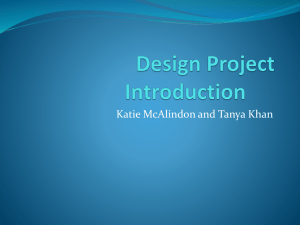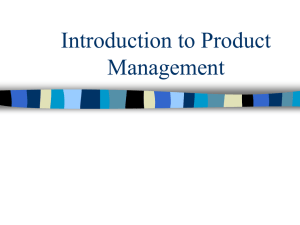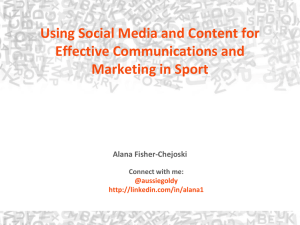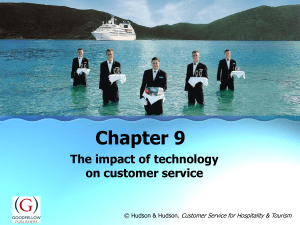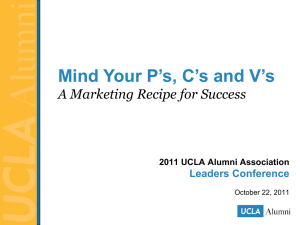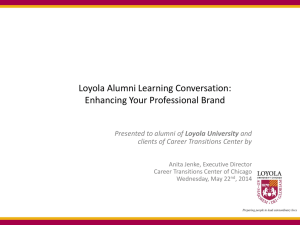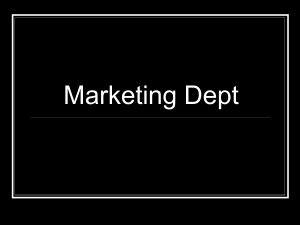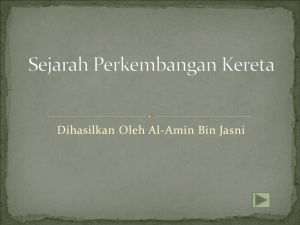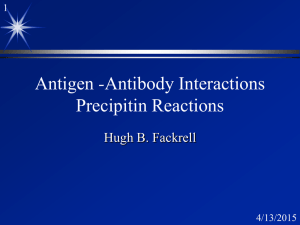The (Secret) Linguistics Behind Brand Names
advertisement
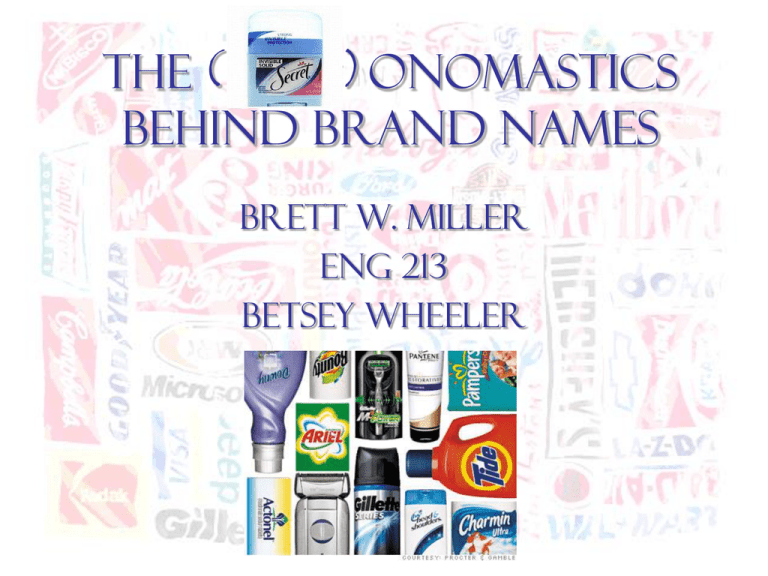
The (Secret) onomastics Behind Brand Names Brett W. Miller ENG 213 Betsey Wheeler onomastics [anomæstIks] (from the Greek onomastikós – to name) (n): 1. the study of the origin, history, and use of proper names. brand [brænd] (from the Old Norse brandr – to burn) (n): 1. kind, grade, or make, as indicated by a stamp, trademark, or the like 2. a mark made by burning or otherwise, to indicate kind, grade, make, ownership, etc. ORIGINALLY, BRANDS WERE SIMPLY NAMED AFTER THE CREATORS OF THE COMPANIES… (after founder George Westinghouse) (after founder Henry Ford) (after founder William E. Boeing) OR A LOFTY BRAND NAME DENOTING THEIR (AT LEAST FORMER) MARKET DOMINANCE… General Motors United Airlines United States (U.S.) Steel BUT TODAY… • Use of Greek or Latin-esque parts of words may be used to allude to a company or product’s qualities or benefits: • Accuracy- should probably be a given when making a car (note the measuring caliper in the logo) • Acuteness? Acuity? • Obvious damage control within this name of cigarette manufacturer Philip Morris’ parent company (“look how altruistic we are”) FOUR ONOMASTIC METHODS COMPANIES USE TO NAME BRANDS (AND SHAPE OUR PERCEPTION OF THEIR PRODUCTS) • ORTHOGRAPHY • PHONEMICS • ABBREVIATIONS • ACRONYMS FOUR onomastic EXAMPLES OF companY Name Brands Unusual use of final “q” in name – moniker may connote impression of “compact,” “computer,” “compatibility,” “quality” Lunar (pertaining to moon and nighttime) + Siesta (alluding to rest and relaxation) = ZZZZZZZ Abbreviation of Badische Anilin und Soda Fabriken (Baden Aniline and Soda Factories) – was originally an Baden, Germany-based aniline dye and soda ash producer A weapon named from an enduring juvenile adventure series of books dating back to the early 20th century – name comprised of the first letters of Thomas A. Swift Electric Rifle (although, in the books, Tom’s middle name was never revealed— guess they had to “buy a vowel”… ORTHOGRAPHY AND PERCEPTION (OR, HOW TO SPELL A SALE) • Studies conducted by four Michigan State University researchers showed that brand names beginning with the consonants B,C,D,G,K,P,T were most easily remembered • Names beginning with B, C, and S were perceived by test subjects as simpler: • Names beginning with X were construed as being masculine: ORTHOGRAPHY AND PERCEPTION (OR, HOW TO SPELL A SALE) • Names beginning with L or V were construed as being feminine: • Names beginning with Q were thought of by the subjects in the brand perception tests as innovative or “cutting edge”: NO MATTER HOW UNUSUAL OR OUTLANDISH THEY LOOK, AMERICAN BRAND NAMES ALWAYS FOLLOW THE LINGUISTIC RULES OF ENGLISH: Zqihfaj ORIGINS OF BRAND NAMES • It’s not a cheer! • “Yahoo” (meaning rude or uncouth) first coined by Gulliver’s Travels author Jonathan Swift • Web portal creators Jerry Yang and David Filo insist that site so named because they were both “yahoos” • Name widely understood as acronym for “Yet Another Hierarchical Officious Oracle” • Yahoo! still better than original name: “Jerry's Guide to the World Wide Web” ORIGINS OF BRAND NAMES • It’s not a verb meaning “to gawk”! • Actually intentional misspelling of the word googol, popularized by mathematician Edward Kasner to describe a very, very large number (10100 or 10 followed by 100 zeroes) — descriptive of the large amount of information indexed by the Web site • Googol does not linguistically derive from any word— created extemporaneously by Kasner’s nine-year-old nephew • Google, not Googol? Founders Larry Page and Sergey Brin tried, but Silicon Valley engineer Tim Beauchamp beat them to the name googol.com ORIGINS OF BRAND NAMES • Swedish farm boy Ingvar Kamprad “strikes” it big selling matches in village of Agunnaryd • Business expands to Christmas ornaments, pens and . . . fresh fish(!) • Forms his own company, IKEA, at age 17 • Names company using the initials of his name: Ingvar Kamprad the name of his family’s farm: Elmtaryd and his native village: Agunnaryd ORIGINS OF BRAND NAMES • Founded by literary types Gordon Bowker, Jerry Baldwin, and Zev Siegel (Bowker a writer, Baldwin and Siegel, teachers) • Starbuck, first mate and coffee lover on Ahab’s ship in Melville’s Moby Dick was inspiration for ubiquitous coffeehouse name • Ahab’s ship’s name was also proposed as a name for the establishment, but a business collaborator countered, “No one’s going to drink a cup of Pequod!” HIDDEN ONOMASTICS OF PHARMACEUTICALS • Perhaps not coincidentally, rhymes with “Niagara” – owing to either the romantic connotation of the region or a reference to the expected “highflow” result of the product • The initial phonemes /vi/ suggest “vitality,” “vigor” or “vim,” while the remaining portion of the word is phonetically similar to “aggression,” thus equating to force or power • The brand taken as a whole has no genuine significance, but is loaded with implication • This drug has a similar /vi/ phonemic component to that of Viagra, only this time appearing in the middle of the word • Also has an allusion to “levitation,” thus hinting about the drug’s “upstanding” benefits to its male consumers HIDDEN ONOMASTICS OF PHARMACEUTICALS • Note the highlighted “A”s in the names of these antihypertensive (for treatment of high blood pressure) drugs • Both contain Angiotensin Antagonists—drugs that interfere with the body’s ability to narrow blood vessels and thus raise blood pressure • Note the “mab” suffix at the end of the generic names of these drugs • Drugs with this suffix are monoclonal antibodies, which are used to treat some cancers and autoimmune disorders by binding to the surfaces of certain cells, thus blocking specific biological processes AFFIX ANATOMY OF THE mab DRUG CLASS Infixes used in monoclonal antibody drugs serve to identify two drug action characteristics: one for the origin or source of the antibody, the other for the antibody’s target ORIGIN / SOURCE If original antibody only produced in mice (not usually used in humans due to adverse = infix of “o” immune response or allergic reaction): ORTHOCLONE OKT®3 (muromonabCD3) If the antibody originates in humans: = infix of “u” AFFIX ANATOMY OF THE mab DRUG CLASS DRUG ORIGIN / SOURCE When parts of the animal antibody are combined with human genetic sequences = infix of “xi” in an structure area common to both animals (called chimeric”) When parts of the animal antibody that are combined with human genetic sequences are variable between both animals (called “humanized”) = infix of “zu” AFFIX ANATOMY OF THE mab DRUG CLASS DRUG TARGET Construction of the infix for the target is usually comprised of a consonant-vowel-consonant combination The final consonant is dropped off if the following infix of the origin or source (e.g. -zu- or -ci-) The target infix is then abbreviated, as in -ci(r)- to denote the circulatory system or -tu(m)- to designate tumors as the intended targets Cancer drug panitumumab pani + tum + u + mab Specific body target Drug-specific prefix (tumor) Antibody of human origin Monoclonal antibody DRUG NAMING AND THE UNITED STATES APPROVED NAMES COUNCIL The United States Pharmacopeia’s drug naming unit, the United States Approved Names Council, approves the generic names of new drugs in their USP Dictionary of USAN and International Nonproprietary Names New name stems for drugs are created only in cases where an existing stem does not accurately represent the compound, its action, structure, use, or other compelling reason New 2008 stem examples and their descriptions include: • -clomol for heat-shock protein inducers, bimoclomal type • -luren for inducers of ribosomal readthrough of nonsense mutation mRNA stop codons In 2008, 95 new drug names were adopted by the USAN . . . • • • • • • • • • • • • • • • • • • • • • • • • • • • • • • • • • • • • • • • • aflibercept albaconazole aleplasinin alogliptin benzoate apricoxib ataluren bafetinib bederocin blinatumomab bupropion hydrobromide canakinumab carmegliptin cetilistat cixutumumab coleneuramide cositecan dabigatran dabigatran etexilate dabigatran etexilate mesylate dapagliflozin davunetide degarelix acetate delafloxacin delafloxacin meglumine denenicokin dirucotide dirucotide acetate droxidopa dutogliptin dutogliptin tartrate efungumab elagolix elagolix sodium elotuzumab entinostat epetirimod esylate esomeprazole potassium farletuzumab fidaxomicin figitumumab • • • • • • • • • • • • • • • • • • • • • • • • • • • • • • • • • • fosbretabulin disodium fostamatinib disodium gabapentin enacarbil gantenerumab hydroxyethyl starch /. iclaprim iclaprim mesylate indeglitazar ingenol mebutate larazotide levomefolate calcium levomefolic acid linaclotide liprotamase lonaprisan mocetinostat dihydrobromide nabiximols naproxcinod nomegestrol acetate obeticholic acid palifosfamide palovarotene pardoprunox pardoprunox hydrochloride pegloticase pozanicline pozanicline tartrate radezolid radezolid hydrochloride ramucirumab remogliflozin etabonate retaspimycin retaspimycin hydrochloride serlopitant • • • • • • • • • • • • • • • • • • • • • sobetirome sofinicline sofinicline benzenesulfonate sotrastaurin acetate spinosad tecovirimat telcagepant telcagepant potassium toceranib toceranib phosphate tozasertib tozasertib lactate turofexorate isopropyl tylvalosin tylvalosin tartrate varespladib varespladib methyl vedolizumab velneperit voreloxin zibotentan HARMFUL LINGUISTICS: how creative orthography can KILL Diabetes drug Alzheimer’s drug Antifungal drug OR Epilepsy drug Antihistamine Schizophrenia drug Pain killer Antidepressant Source: http://www.chem.cornell.edu/jn96/images/Top%20200%20Brand%20Name%20Drugs%20by%20Retail%20Dollars%20in%202007.png Top ten drug onomastics 1. 2. 3. 4. 5. 6. 7. 8. 9. 10. Lipitor Nexxium Advair Diskus Prevacid Plavix Singulair Seroquel Effexor XR Lexapro Actos “lipid,” cholesterol “next generation antacid” “advanced airway opener” (disc shape) “prevents acid” “nixes plaques” “singular” (exclusivity?) and “air” “quells serotonin” “effective” - XR is eXtended Release “lexa-a linguistics term meaning a relation word?” “promotes” “active” perhaps “glucose?” THE ONOMASTIC STORIES BEHIND CAR BRANDS Name derives from the Japanese word for the constellation known in English as the Pleiades, or “the Seven Sisters” Count the stars in the logo! (Although there are many more stars, these are purportedly the stars most visible by naked eye from Earth) Represents the company’s formation from the merger of seven separate companies THE ONOMASTIC STORIES BEHIND CAR BRANDS Named for company co-founder Louis Chevrolet Chevrolet was a well-known Swiss auto racer in the early 1900s Originally a separate car make, became part of GM in 1917 THE ONOMASTIC STORIES BEHIND CAR BRANDS The name is Latin for “let it be done” (also an English word meaning “an authoritative order or decree”) Italian auto maker’s name actually derives from the acronym Fabbrica Italiana Automobili Torino (Italian Automobile Factory of Turin) Car model Names Volkswagen Touareg • German pronunciation is like "too," a quick "ah," then "reg“ [tuərɛg] • Too hard for English speakers to pronounce (we say [tʊrɛg]) • Named for the Tuareg, a nomadic people of North Africa Car model Names Toyota camry • Name is phonetic compression of kamuri, a Japanese word meaning “crown” • Not the first of Toyota’s “crowning” achievements: • Toyota Crown • Toyota Tiara • Toyota Corona • Toyota Corolla Cars named for “wind” • • • • • • • • Volkswagen Scirocco (hot desert wind) Mercury / Lincoln Zephyr (gentle breeze) Volkswagen Passat (German for “trade wind”) Plymouth Breeze Dodge Hurricane Mercury Cyclone Renault Wind Nissan Mistral (cold, dry, and often violent wind in France) onomastic nightmares on wheels: Car names that shouldn’t have been • Mazda Laputa – the car’s name, describing its small or “Lilliputian” nature, is, unfortunately, also Spanish for “the whore” • Mitsubishi Pajero – another disaster en Español, translates to “wanker” or “one who masturbates” • Buick LaCrosse – slang amongst teenagers in Quebec, see Pajero above • Opel Ascona – in Spain and Portugal, strong pejorative for the female reproductive anatomy (rhymes with stunt) • Honda Fitta – in Sweden and Norway, see Ascona above onomastic nightmares on wheels: Car names that shouldn’t have been • Daihatsu Charade – defined by the dictionary as “a blatant pretense or deception” – yeah, sounds like a good name for a car. . . • AMC Gremlin – dictionary definition: a mischievous invisible being, said by airplane pilots in World War II to cause engine trouble and mechanical difficulties – Enough. Said. • Rolls-Royce Silver Mist – mist is German for dung or manure, but at least it was a Rolls. . . and silver! • Ford Pinto – In America, means “spotted horse” in Brazil and Portugal, means “male reproductive anatomy” How NOT to make a brand name memorable Works cited "Approved stems." American Medical Association. 22 Oct. 2008. American Medical Association. 3 Nov. 2008 <http://amaassn.org/ama/pub/category/print/4782.html>. Acharya, Hem. "Badly Chosen Car Names." Tech, Fun, This n That. 2006. Hem Acharya. 7 Dec. 2008 <http://hem.com.np/2008/05/04/badly-chosen-car-names/>. Casselman, William G. "Autoneokakonymia: when automobile names get silly and stupid." Bill Casselman's Canadian Word of the Day and Words of the World. 2008. William Gordon Casselman. 7 Dec. 2008 <http://www.billcasselman.com/unpublished_works/bad_car_names.htm>. Frankel, Alex. Wordcraft: The Art of Turning Little Words Into Big Business. New York, NY: Crown, 2004. 158-59. Kimball, John W. "Monoclonal Antibodies." Kimball's Biology Pages. 1 Dec. 2008. John W. Kimball. 6 Dec. 2008 <http://users.rcn.com/jkimball.ma.ultranet/biologypages/m/monoclonals.html>. "List of company name etymologies." Wikipedia. 4 Dec. 2008. Wikimedia Foundation, Inc. 4 Dec. 2008 <http://en.wikipedia.org/wiki/list_of_company_name_etymologies>. Works cited "Monoclonal antibodies." Wikipedia. 25 Nov. 2008. Wikimedia Foundation. 6 Dec. 2008 <http://en.wikipedia.org/wiki/monoclonal_antibody>. Neergaard, Lauran. "Similar drug names can cause deadly mistakes: New Web tool helps check on error-prone medications." Seattlepi.com. 1 Sept. 2008.Seattle Post-Intelligencer.6 Dec. 2008 <http://seattlepi.nwsource.com/national/377337_drugs02.html>. Morris, Evan. From Altoids to Zima : The Surprising Stories Behind 125 Famous Brand Names. New York: Simon & Schuster, Incorporated, 2004. 99-102. Pinker, Steven. The Stuff of Thought:Language as a Window into Human Nature. New York, NY: Viking, 2007. 303-04. "Pleiades." Wikipedia. 4 Dec. 2008. Wikimedia Foundation, Inc. 7 Dec. 2008 <http://en.wikipedia.org/wiki/pleiades_(star_cluster)>. Robins, Rebecca. "Brand Matters: The Lingua Franca of Pharmaceutical Brand Names." Weblog post. Brandchannel.com. 31 Mar. 2006. 7 Nov. 2008 <http://www.brandchannel.com/papers_review.asp?sp_id=1233>. Works cited "Starbucks." Wikipedia. 3 Dec. 2008. Wikimedia Foundation, Inc. 5 Dec. 2008 <http://en.wikipedia.org/wiki/starbucks>. "Toyota Camry." Wikipedia. 5 Dec. 2008. Wikimedia Foundation, Inc. 7 Dec. 2008 <http://en.wikipedia.org/wiki/toyota_camry>. "Tuareg." Wikipedia. 3 Dec. 2008. Wikimedia Foundation, Inc. 7 Dec. 2008 <http://en.wikipedia.org/wiki/tuareg>. United States Adopted Name Council, comp. "Adopted names." American Medical Association. 2 Dec. 2008. United States Adopted Names CouncilUnited States Pharmacopeia. 6 Dec. 2008 <http://www.amaassn.org/ama/pub/category/9615.html>.
